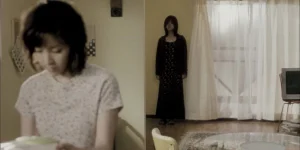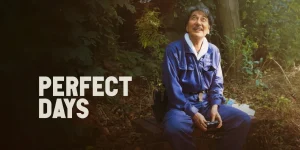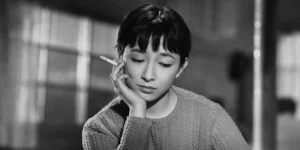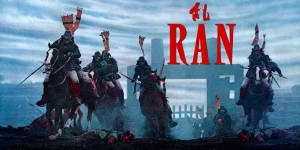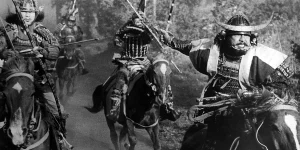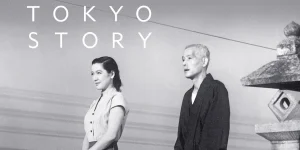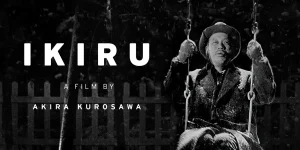Cure is a 1997 Japanese psychological horror thriller directed by Kiyoshi Kurosawa, and often regarded as one of the foundational films of the modern J-horror wave. It stands out for its chilling atmosphere, slow-burn tension, and existential dread rather than overt scares. If you’re into psychological disintegration, philosophical horror, and ambiguous storytelling, this one’s a must-see.
Table of Contents
ToggleDetailed Summary
A String of Gruesome Murders
Set in Tokyo, Cure follows a detective named Kenichi Takabe (played by Kōji Yakusho) who is investigating a series of bizarre and brutal murders. Each victim is killed in the same gruesome way—a large X carved into their throat—but the perpetrators are all different people who have no prior criminal records and no clear motive. After the murders, each killer appears to be in a dissociative state, unable to explain why they did it.
What makes things more disturbing is that these killers are calm and cooperative after the murders, but completely oblivious to their actions, as though they had been hypnotized or possessed.
Enter Mamiya: The Amnesiac Suspect
Eventually, Takabe and his partner Sakuma encounter a drifter named Mamiya (Masato Hagiwara), a young man with extreme short-term memory loss—or so he claims. He repeatedly asks people, “Who are you?” and “Where am I?” Moments after being questioned, he seems to forget everything again. But there’s something menacing underneath his vacant demeanor.
Mamiya becomes the central suspect, not for committing the murders himself, but for orchestrating them through hypnosis, compelling ordinary people to become killers.
The Psychological Toll on Takabe
As Takabe delves deeper into the case, he begins to fray at the edges. His personal life is a wreck; his wife is suffering from a mental illness, and he is barely holding himself together. The more time he spends with Mamiya, the more disturbed he becomes, often losing track of time and place. Mamiya’s calm, blank presence begins to affect Takabe’s psyche, pulling him into a spiral of paranoia and existential dread.
The film blurs the line between sanity and madness, pushing the viewer to wonder: is Takabe solving a case, or becoming part of it?
Movie Ending
In the final act, Takabe finally confronts Mamiya in an abandoned hospital. Mamiya seems to suggest that his hypnotic abilities are not some kind of party trick but rather a deep manipulation of the human subconscious, unlocking the primal urge to kill that exists in everyone.
After a tense scene where Mamiya tries to hypnotize Takabe, Takabe shoots and kills him. At first, it seems like justice is served—but this is where Cure takes a sinister turn.
In the final scenes, we see Takabe eating in a restaurant, seemingly calm. The waitress serving him then receives a phone call. After hanging up, her face shifts—she walks slowly toward the kitchen, picks up a large knife, and walks offscreen. The movie ends.
What does this mean?
The implication is chilling: Takabe may have absorbed or learned Mamiya’s hypnotic technique, and has now become the new “carrier” of the curse. The “cure” is not a cure at all—it’s a contagion, passed from person to person. Mamiya didn’t just hypnotize others—he taught them how to pass it on.
The film leaves the final act ambiguous, but strongly implies that Takabe has transformed from detective to the new source of evil.
Are There Post-Credits Scenes?
No, Cure does not include any post-credits scenes. The film ends on a haunting note and gives the audience no relief, resolution, or explanation afterward—which is exactly how Kiyoshi Kurosawa wants it.
Type of Movie
Cure is a psychological horror thriller with elements of supernatural mystery and crime drama. Unlike gore-heavy horror films, it relies on atmosphere, silence, and the horror of the human mind to build terror.
Cast
- Kōji Yakusho as Detective Kenichi Takabe
- Masato Hagiwara as Kunio Mamiya
- Tsuyoshi Ujiki as Sakuma (Takabe’s partner)
- Anna Nakagawa as Fumie Takabe (Takabe’s wife)
- Yukijirō Hotaru as Police Psychiatrist
Film Music and Composer
The film has very minimal music, and most of its score is made up of ambient sounds and disturbing silences. When music is used, it’s dissonant and sparse, composed by Gary Ashiya. This minimalist approach intensifies the psychological unease throughout the film.
Filming Locations
The movie was shot entirely in Tokyo, utilizing real urban settings—hospitals, alleyways, apartments—to heighten realism. The city’s bleak, drab, and rain-soaked visuals reflect the emotional and mental desolation of the characters.
Awards and Nominations
- Yokohama Film Festival: Best Actor (Kōji Yakusho)
- Fantasia International Film Festival: Jury Prize
- Frequently appears in “Top Horror Films of All Time” lists from critics and film historians.
Behind the Scenes Insights
- Kiyoshi Kurosawa was inspired by Freud, Jung, and the idea of the unconscious mind as a source of horror.
- The film was made on a modest budget, with a focus on performance and atmosphere over visual effects.
- Kurosawa encouraged improvisation and long takes to create natural unease.
- Kōji Yakusho reportedly stayed isolated from other actors to better reflect his character’s alienation.
Inspirations and References
- Based loosely on real-life concepts of mesmerism and hypnosis in the 19th century.
- Philosophical inspirations from Freud, Nietzsche, and Japanese spiritual mysticism.
- Shares thematic DNA with Se7en (1995), Silence of the Lambs (1991), and Possession (1981).
- Kurosawa has said he wanted to explore how “evil” can spread without logic or motive.
Alternate Endings and Deleted Scenes
There are no known alternate endings for Cure, though some extended sequences exist in early cuts that provided more backstory for Mamiya. These were removed to preserve ambiguity.
Book Adaptations and Differences
Cure is not based on a book, but it has inspired several academic texts and essays analyzing its psychological and philosophical undertones. Some scholars have interpreted the film as an allegory for Japan’s post-economic bubble identity crisis.
Memorable Scenes and Quotes
Key Scenes
- The first hypnotic murder scene, setting the film’s chilling tone.
- Mamiya interrogating Takabe in the hospital, where control seems to shift.
- The reveal that each killer has a different but equally empty motive.
- The final restaurant scene with the waitress picking up the knife.
Iconic Quotes
- Mamiya: “Who are you?”
- Takabe: “You’re trying to hypnotize me again, aren’t you?”
- Mamiya: “I’m just helping people to be themselves.”
Easter Eggs and Hidden Details
- The recurring “X” symbol carved into victims may also refer to a crossed-out identity—a symbolic erasure of the self.
- Mamiya’s constant forgetfulness is a metaphor for identity loss and mental disintegration.
- Several background characters mimic small gestures from Mamiya, hinting that his influence is broader than just the main victims.
Trivia
- Kiyoshi Kurosawa is not related to Akira Kurosawa, despite the surname.
- The film heavily influenced later J-horror titles like Pulse (Kairo) and Audition.
- Bong Joon-ho (director of Parasite) cited Cure as one of his favorite films of all time.
- The hypnotic technique used by Mamiya is based on actual methods used in experimental psychology.
Why Watch?
Cure is not your average horror film. It’s terrifying not because of what it shows, but because of what it suggests—that evil can be meaningless, contagious, and lurking beneath the surface of everyday life. If you’re drawn to psychological horror, existential dread, and mind-bending storytelling, Cure is essential viewing.
Director’s Other Movies
- Pulse (2001)
- Tokyo Sonata (2008)
- Creepy (2016)
- Daguerreotype (2016)
- Wife of a Spy (2020)
Recommended Films for Fans
- Audition (1999)
- Pulse (2001)
- The Wailing (2016)
- Se7en (1995)
- The Vanishing (1988)
- Possession (1981)



